Performance & Battery Life Report: Xiaomi Redmi Note 4 with MediaTek Helio X20
by Matt Humrick on February 23, 2017 7:00 AM EST- Posted in
- Smartphones
- Mobile
- Xiaomi
- MediaTek
- Helio X20
- Redmi Note 4
GPU & Gaming Performance
The Redmi Note 4’s Helio X20 SoC includes a Mali-T880MP4 GPU running at up to 700MHz. Based on ARM’s now last-generation Midgard architecture, it still supports all of the latest graphics APIs, including OpenGL ES 3.1 + Android Extension Pack (AEP). The T880 is the highest performing Midgard GPU, with 3 ALUs/core, but MediaTek is using a modest four-core configuration.
We’ve seen this same configuration in HiSilicon’s Kirin 950/955 (Mali-T880MP4) that’s used in Huawei’s Honor 8, Mate 8, and P9. The only difference is the Kirins’ Mali ramps up to 900MHz. The Redmi Note 4’s lower peak frequency limits FP32 throughput to a theoretical 84 GFLOPS compared to 108 GFLOPS in the three Huawei phones, and because each GPU core contains a single texture unit, along with supporting hardware for triangle setup, tiling, rasterization, etc., it’s not just ALU performance that’s limited by using fewer cores; even workloads that are not shader bound take a performance hit.
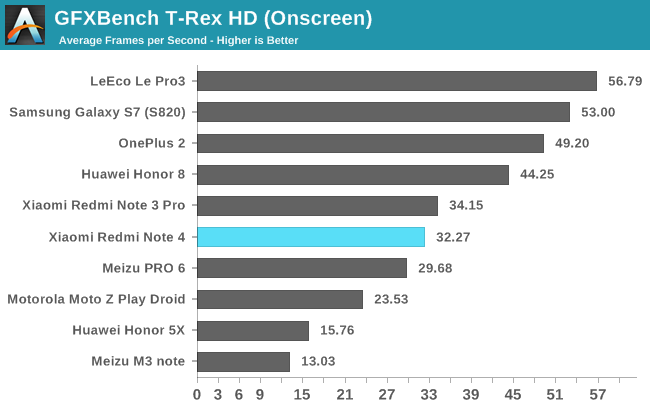
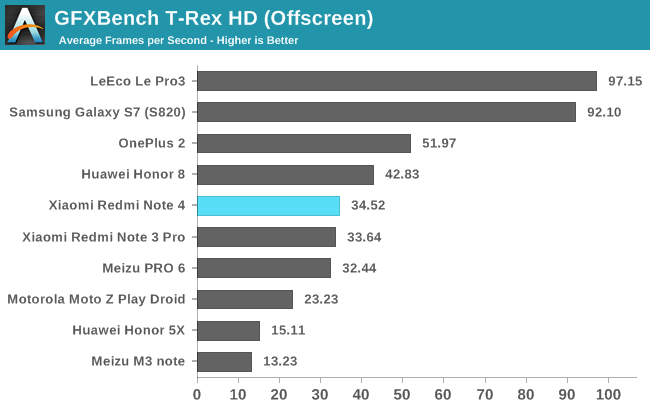
In the older OpenGL ES 2.0-based GFXBench T-Rex game simulation, both the Redmi Note 4 and Meizu Pro 6 essentially match the Redmi Note 3 Pro’s performance. Their T880MP4 GPUs readily outpace the Adreno 506 GPU in the Moto Z Play’s Snapdragon 625 SoC and the T860MP2 GPU in Meizu’s M3 note. As expected, the Honor 8 performs 24% faster than the Redmi Note 4 based on its frequency advantage.
The Adreno 530 GPU in LeEco’s Le Pro3 and Samsung’s Galaxy S7 is the only one in these charts capable of hitting vsync when rendering onscreen. Because all of these phones except for the 1440p Galaxy S7 have 1080p displays, there’s no appreciable difference between offscreen and onscreen results.
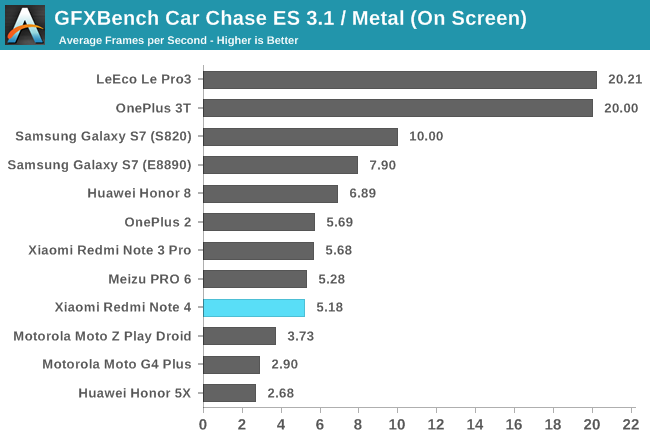

GFXBench Car Chase uses a game engine based on OpenGL ES 3.1 + Android Extension Pack (AEP) and employs several modern features, such as tessellation and compute shaders, that stress ALU performance.
Despite the difference in workload, the results are largely the same. The Honor 8 maintains a nearly 24% advantage over the Redmi Note 4, while the latter still holds the advantage over the lower-end Adreno GPUs in the Moto Z Play and Moto G4 Plus.
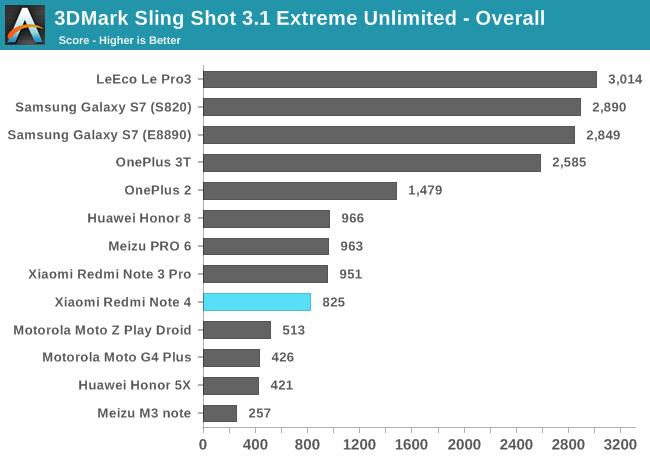
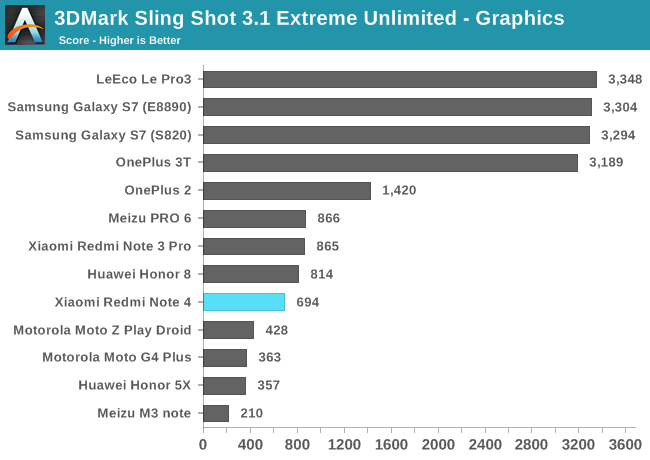
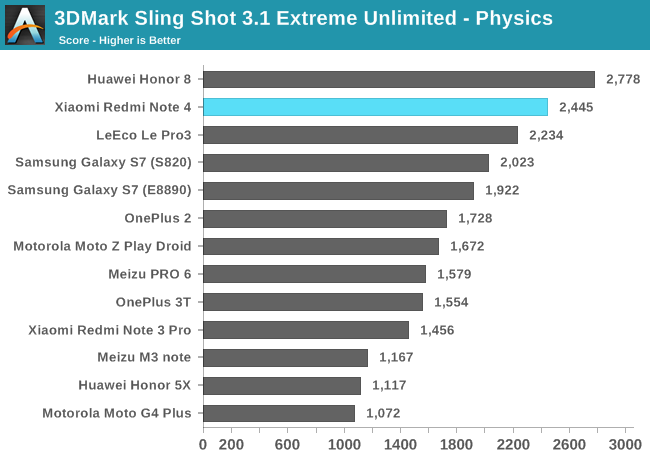
3DMark Sling Shot Extreme uses OpenGL ES 3.1 on Android and stresses the GPU and memory subsystems by rendering offscreen at 1440p (instead of 1080p like our other tests).
With so many pixels to process it’s no surprise to see the flagship devices using Snapdragon 820/821 or Exynos 8890 SoCs perform at least 4.6x faster than the Redmi Note 4 and the other less-expensive phones, whose GPUs were never intended to drive 1440p displays. While the Note 4, Note 3 Pro, and Pro 6 were pretty evenly matched in the GFXBench tests, the latter two pull ahead of the Note 4 by 25% in this test. In the case of the Note 3 Pro, the larger portion of its advantage (35%) comes in the first graphics test that focuses on geometry processing.
The Physics test, which is based on the Bullet Open Source Physics Library, runs several multi-threaded simulations on the CPU and is heavily influenced by memory controller performance. The Redmi Note 4 handles this workload especially well, effectively leveraging its 10 CPU cores to pull away from the Redmi Note 3 Pro and the other phones in the second and third subtests that each add additional simulation threads.
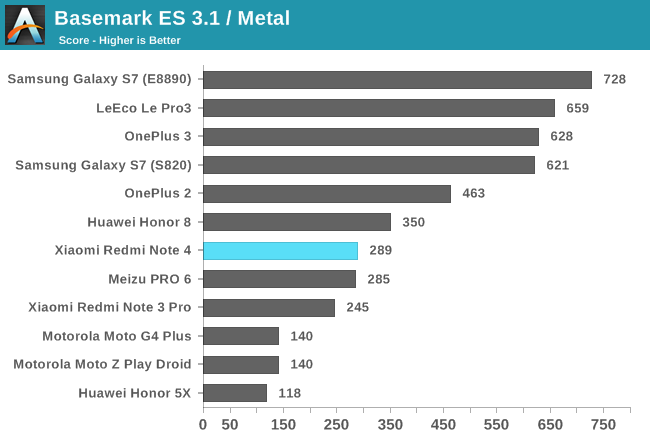
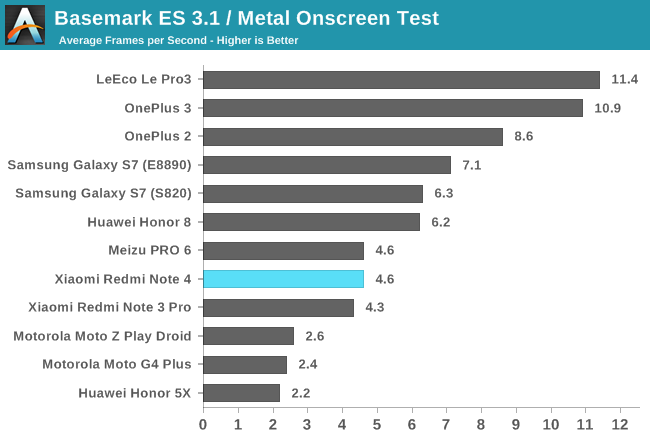

As its name implies, the Basemark ES 3.1 simulation uses OpenGL ES 3.1 on Android. It’s a demanding test that uses a number of post-processing, particle, and lighting effects, but does not include tessellation like GFXBench 4.0 Car Chase.
While Qualcomm’s Adreno GPUs generally provide better ALU performance than ARM’s Mali GPUs at the same price tier, we’ve consistently seen Mali pull ahead of Adreno in Basemark ES 3.1. In the previous tests, the Redmi Note 4 performed the same as or a little behind the Redmi Note 3 Pro and its Adreno 510 GPU, but here the Note 4 pulls ahead by 7% in the onscreen test.
Most people who list gaming as a priority are probably willing to pay a little extra for a more performant GPU. For phones below the $200 USD mark, like the Redmi Note 4, price/area and power are the motivating criteria. It’s no surprise then that the peak GPU performance of Xiaomi’s latest Note falls well below the numbers from mid-range phones and even flagships from a couple years ago like Samsung’s Galaxy S6; however, its performance is actually quite good compared to the phones it’s competing with in its price bracket. It also supports the latest graphics APIs and features, including tessellation, and is still capable of playing the majority of games currently available with acceptable frame rates. There are occasional stutters, however, so it would be nice to see a higher peak GPU frequency to boost performance when needed, but I suspect it’s being limited by the Helio X20’s 20nm planar process.










34 Comments
View All Comments
leo_sk - Friday, February 24, 2017 - link
Maybe 625 was a good upgrade, 650 and 652 left only battery life as positive point. Had they been built at same process instead of 28nm, they would have dulled the battery advantage quite a bit too. But then, that would have left 820 with gpu advantage alone. I wonder why samsung or huawei dont come with a chipset with a73 and bit descent gpu (880 mp4 or g71 mp4) at 20 or 28 nm process for upper midrange products.dexterkarthik - Friday, February 24, 2017 - link
The simple reason Xiaomi could not release the Chinese Helio equipped RN4 was because of the patent and other legal restrictions with MediaTek chips. They wanted to keep the costs down and hence went for the 62x instead of 65x.There will still be hoards of people buying RN4 considering it is "OCTA" core compared to JUST hexa-core of RN3. Most still do the same.
The ignorance of the majority is benefit to the minority :D and I am not complaining either. ;)
mpokwsths - Friday, February 24, 2017 - link
It's been a long time since I read such a ridiculous comment.SD625 is the most power efficient SoC of our time.
Also in terms of CPU performance gives the SD650 a run for its money. (see Geekbench 3/4 scores). Not only that but it sustains the performance for long long time before throttling.
SD650 / SD652 are 28nm inefficient dinosaurs and have absolutely no place in the mobile world of 2017.
ados_cz - Friday, February 24, 2017 - link
SD625 is the most power efficient SoC of our time. And that is why I bought Redmi Note 4 for my wife for £145 brand new for the international version. She is coming from Galaxy Note 2 and was complaining about battery life. I think the performance is just fine and it is a best value phone I could find.leo_sk - Saturday, February 25, 2017 - link
Single core score of note 3 (SD650) is almost twice that of note 4(SD625). Multicore is 14% higher in geekbench 4https://browser.primatelabs.com/v4/cpu/search?q=re...
serendip - Saturday, February 25, 2017 - link
Not really. Check out the XDA review of the Note 4 Snapdragon variant, the 625 beats the 650 on battery life because of process efficiency but it still loses on performance. You get +10% better battery life on the Note 4 625 but the Note 3 650 has powerful A72 cores which help speed up browsing and app loading. A 650/652 on 14nm would make the 8xx series chips superfluous, maybe that's why Qualcomm went with an older and cheaper process.dexterkarthik - Saturday, February 25, 2017 - link
So Core i7 2600k is inferior compared to the latst core i3 7350K ? ( ROFLoLMAO)leo_sk - Saturday, February 25, 2017 - link
Redmi note 3 was cheaper at release than note 4. Though screen was lower qualitywatzupken - Friday, February 24, 2017 - link
Personally, I feel the Qualcomm mid range SOCs are very confusing. There are too many SD 6xx series out in the wild. And honestly, I am disappointed with the performance of the SD 625 which they are marketing as mid range SOCs when I feel they are more like low end SOCs. The lack of the A72 cores and a weaker graphic left it behind the SD 65x series and significantly behind their top end SD 82x. The only saving grace is that it is produced on 14nm, which made it more power efficient and allows for higher clockspeed. The true mid range SOC will likely be SD 660 that will succeed SD 65x.dexterkarthik - Saturday, February 25, 2017 - link
Bulls eye! (Y)